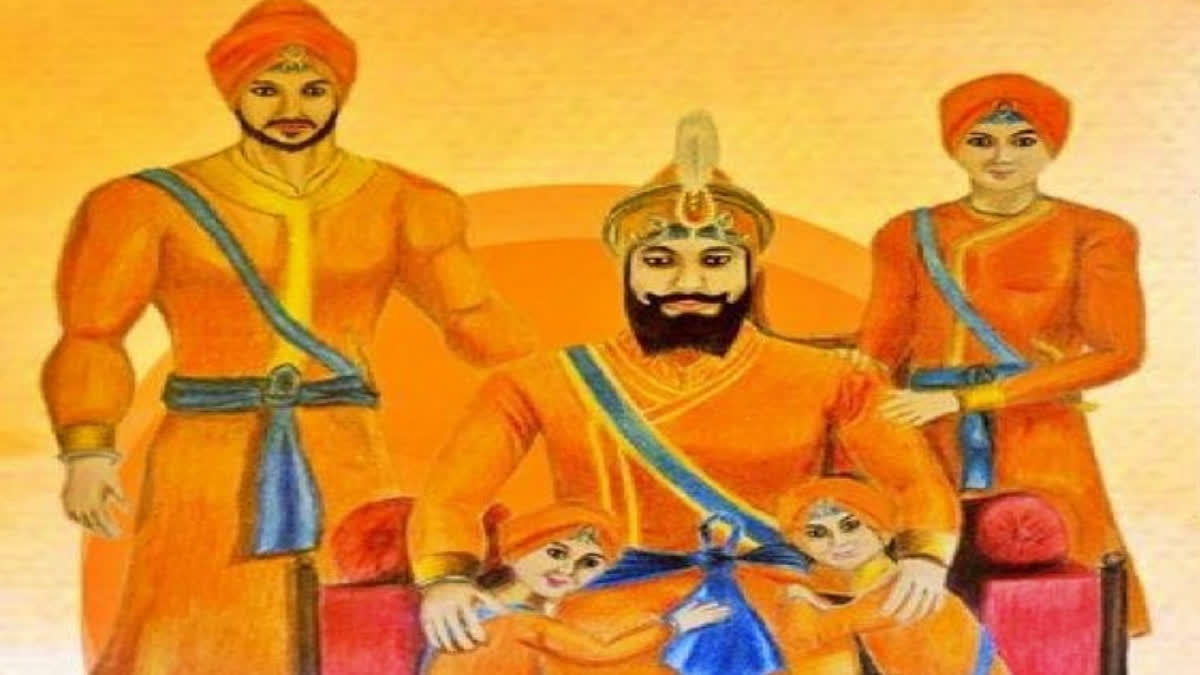Hyderabad: Veer Bal Diwas is a day to remember and pay tribute to the martyrdom of Guru Gobind Singh's sons, Fateh Singh and Zorawar Singh. On January 9 2022, on the birth anniversary of Guru Gobind Singh, Prime Minister Narendra Modi declared that December 26 would be observed as 'Veer Bal Diwas' in remembrance of the Sikh guru's sons' martyrdom. The day was announced in honour of Sri Guru Gobind Singh Ji's Prakash Parv. Guru Gobind Singh was the founder of the Khalsa and the tenth Guru of Sikhs.
History: In remembrance of Sahibzada Zorawar Singh and Sahibzada Fateh Singh's sacrifices, Veer Bal Diwas is observed. On this day in Sirhind, Punjab, Mughal forces killed Sahibzada Zorawar Singh, who was just six years old, and Fateh Singh, who was only nine.
Sahibzada Ajit Singh, Sahibzada Jujhar Singh, Sahibzada Zorawar Singh, and Sahibzada Fateh Singh were the four sons of Guru Gobind Singhji. The tenth and last Sikh guru was Guru Gobind Singhji. At the Anandpur Sahib Fort, the Mughal Army attacked Guru Gobind Singhji and his troops. Following the Mughals' months-long siege of the Anandpur Sahib Fort, food supplies and other necessities began to run low. By now, Aurangzeb had offered Guru Gobind Singhji and his family safe passage out of Anandpur.
Guru Gobind Singhji's younger sons were Zorawar Singh and Fateh Singh. The Mughal army took them captive and made them convert to Islam. The two youthful Sahibzadas declared their devotion to their religion and declined to convert. The emperor then gave the army the command to bury them alive between the walls.
Significance: The four sons of the last Sikh guru, Guru Gobind Singh, are known as the "Sahibzades," and Veer Bal Diwas is a day to celebrate them. December 26 was designated as the day of the youngest Sahibzade's sacrifice. Although the two youngest, Zorawar Singh and Fateh Singh, were also slaughtered when they were six and nine years old, all four were murdered.
Facts of Veer Bal Diwas:
- Zorawar Singh and Fateh Singh, the youngest of Guru Gobind Singh's four sons, are revered as the most sacred martyrs in Sikhism.
- The sons of the Tenth Guru, Guru Gobind Singhji, are known as Sahibzade.
- Baba Zorawar Singh and Baba Fateh Singh are referred to as younger Sahibzade, whereas Baba Ajit Singh and Baba Jujhar Singh are known as older Sahibzade.
- Their grandma reared them after they lost their mother when they were quite small.
- When Guru Gobind Singh established the Khalsa Panth in 1699, his family resided at Anandpur.
- A bloody conflict between the Mughals and Guru Gobind Singh and his family broke out close to the River Sarsa, also known as Sirsa when the latter group departed the Fort of Anandpur Sahib. The members of Guruji's family split up during the River Sarsa crossing.
- Around 1704, Aurangzeb, the Mughal Emperor, stormed and besieged Anandpur.
- Following months of fort holding, food and other essentials began to run low, thus Guru Gobind Singh and his family agreed to take Aurangzeb's offer of safe passage out of Anandpur. The two sons of Guru Gobind Singh, Zorawar Singh and Fateh Singh were captured during this period. In the end, when they were just 8 and 5 years old, they were buried alive inside a wall.
- When a troop of Sikhs led by Guru Gobind Singhji and his older Sahibzade arrived at the Chamkaur citadel on December 23, 1704, Baba Ajit Singh and Baba Jujhar Singh were slain in a battle against 10,000 brutal Mughal soldiers.
- Sahibzade, the younger, and Mata Gujriji were brought to Gangu's hamlet, Cheri, by Gangu, the Guru's elderly chef. He had Mataji and the younger Sahibzade jailed out of greed.
- Wazir Khan, the despotic Nawab of Sarhind, imprisoned them in Thanda Burj and forced them to appear in court for three days. If they did not accept Islam, they would be killed, it was threatened.
Numerous salutations are extended to the two young Sahibzade, who gave their lives at a very young age to preserve the honour of Sikhism and stand up for their ideals.



